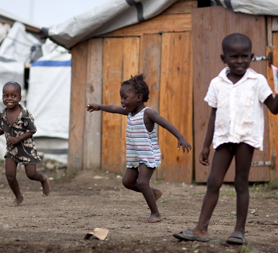Haiti cholera outbreak: one boy’s story
An 11-year-old boy caught up in the cholera outbreak in Haiti tells his story to Save the Children’s Elysia Nisan for Channel 4 News.

More than 1,100 people have died from cholera in Haiti – another 20,000 have fallen sick.
Aid agencies working to beat the cholera in Haiti said the aid response is “inadequate” and they are struggling to cope with the tide of new cases.
Elysia Nisan, working for Save the Children in the country, told Channel 4 News her experience of meeting one boy caught up in the epidemic. He paid close attention to messages over prevention and treatment and they may have saved his life.
Wawins’ story
I met 11-year-old fifth-grader Wawins in the cholera treatment unit, or CTU, at Delmas 56 in Port-au-Prince. This boy was the first patient of our CTU and, while it makes us all very concerned that cases are continuing to appear in new areas, we are heartened that prevention messages are reaching the beleaguered population.
Wawins did exactly what he should have when he suspected cholera: sought treatment. When he first had stomach pains, he immediately told his mother. He explained to me: “In school they taught us that as soon as we don’t feel good we have to go to a doctor.”
“In school they taught us that as soon as we don’t feel good we have to go to a doctor.” Wawins, an 11-year-old boy in Haiti.
He paid attention in school and this little piece of advice that stuck in his memory may have saved his life.
Cholera outbreak
Wawins’ father, Wiam Claudel, lives in the Delmas 56 camp where Save the Children has run a health clinic since January. When the cholera outbreak began, Save the Children built a CTU on the site. There, strict cholera protocols are maintained. Before entering the unit, like everyone else, I have to wash my hands and step through chlorinated waters – and do the same on the way out to make sure bacteria are not spread. The CTU is a secure location with 24-hour staff who care for patients. The atmosphere is friendly and positive.
When I arrived, it was nearing the time of Wawins’ discharge. He was fully treated and all better. He felt quite strongly that people need to listen to the messages that urge the population to protect themselves.
“On the radio, they tell us that we must always wash our hands after going to the bathroom and before eating. At school we have to wash our hands after recreation time,” Wawins said.
More on the Haiti cholera outbreak from Channel 4 News
“Here they have really helped me. They stayed with me during the night,” he said, holding up a brightly-coloured plastic cup, “and they brought my water.”
More aid needed
Wawins’ father is thankful for the CTU.
“This is what we need here right now, and we need more of them,” he said.
Wawins then told me how he’s ready to go back to school because he likes all his classes and he misses his friends. He is a healthy boy who survived a killer (but treatable) disease, only because he followed a few simple steps. He may have been the first in his area to become infected, but he is a testament to why our work in sharing messages about prevention and action, so far to over 340,000 people since the earthquake, is so important. With that knowledge, he saved his life.